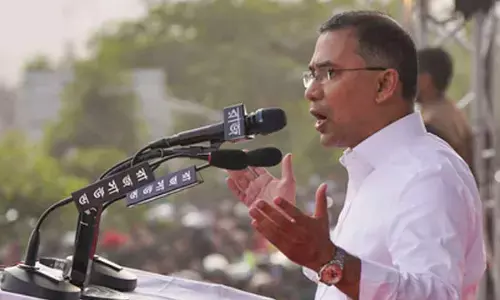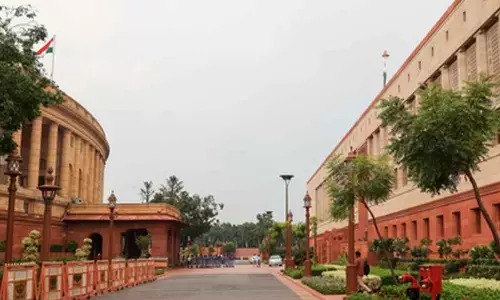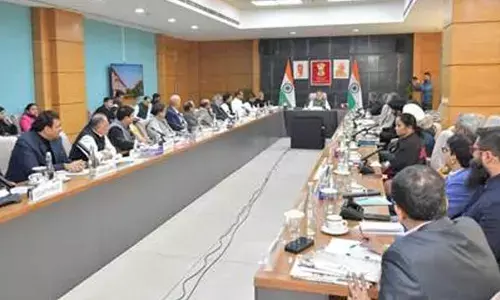Six judgements that safeguarded liberty, democracy

Supreme Court
On 4 August 1958, Dr Rajendra Prasad, the first President of India while inaugurating the new building of the Supreme Court, vividly explained what the new building of the Supreme Court symbolises.
On 4 August 1958, Dr Rajendra Prasad, the first President of India while inaugurating the new building of the Supreme Court, vividly explained what the new building of the Supreme Court symbolises.
He said, "Traditionally we look upon justice as a pair of scales the two pans of which have to be held evenly without allowing the beam from which they hang to incline to one side or the other. We see two wings on the two sides. They will accommodate the offices and the records. At the end of each wing is a semi-circular structure. They represent the pans that are attached to the beam at the top. This beam will accommodate the courtrooms wherein the Hon'ble judges will sit and dispense justice without inkling either to the right or to the left."
Today India is celebrating its 76th Independence Day. Seven decades have passed and this time period witnessed many democratically elected governments with different ideological hues assuming power at the Centre. However, in these seven decades, the Supreme Court of India successfully held the balance of the scales of justice intact without "tilting" to any side.
There have been 'dark hours' of the Indian judiciary, there have been numerous disappointments in dispensing justice, and there have been incidences that cast a dark shadow of doubt on the expanse of the majestic building termed as the "temple of justice".
But on each occasion, India's apex court managed to survive and come out stronger. Indian Supreme Court managed to uphold the trust of crores of people who sees it as a guardian of their rights.
India in 1947 was enmeshed in its complex social, economic and political realities. Post-independence the foremost challenge before the new polity was to balance individual rights against state actions that were required for the social revolution that the framers of the Indian constitution wanted India to usher in. Soon after independence, India's reform agenda came into direct conflict with individual rights, leading to several amendments that in turn were challenged before the court.
Supreme Court had to tread a tightrope in deciding these cases. It was tasked with the demanding job of securing the fundamental rights of the people and at the same time accommodating the concerns of the government that was trying to shape the trajectory of the newly independent country.
Barring a few cases, the Supreme Court of India in the last seven decades have managed to maintain a fine balance between the state's actions and citizens' right.
In the last seven decades through its numerous landmark judgments, the Supreme Court contributed immensely to expanding the scope of individual liberty and freedom and strengthening the democratic edifice of the country.
Kesavananda Bharati versus the State of Kerala
Swami Kesavananda Bharati was head of Edneer Mutt at Kerala's Kasaragod who challenged the Kerala government's attempt under the two-state land reform acts to impose restrictions on the management of the religious property. According to British jurist and historian Granville Austin, it was a local lawyer who wrote to JB Dadachanji, the famous Supreme Court lawyer, who in turn shared the letter with famous jurist NA Palkhivala who agreed to take the case as he felt that the case could lead to important Supreme Court judgments. Palkhivala was right in his assessment of the importance of the case as it actually led to a judgment that changed the course of the constitutional history of India and created a solid bulwark against any attempt to subvert the constitution by any totalitarian regime in the future.
While Dadachanji and Palkhivala convinced Swami Kesavananda Bharti into fighting the case under Article 29 of the Constitution, concerning the right to manage the religiously-owned property without government interference, grander issues of Parliaments' power to amend the Constitution arose as court proceedings evolved.
By creating the defensive wall of 'basic structure doctrine' the judgment made it nearly impossible for any future government to amend the Constitution in a manner that takes away its democratic essence and its highest regard for the fundamental rights of the citizens.
In the 703-page judgment with a thin majority of 7:6, the apex court held that Parliament could amend any part of the Constitution so long as it did not alter or amend "the basic structure or essential features of the Constitution".
Commenting upon Kesavananda Bharati, India's one of the most respected judges VR Krishna Iyer wrote, "While infallibility is no attribute of a Constitution, its fundamental character and basic structure cannot be overlooked. Otherwise, the power to amend may include the power to repeal. This is a reductio ad absurdem. By a stroke of judicial creativity, the amendatory provision of Article 368 was justly handcuffed in Kesavananda Bharati."
ADM Jabalpur versus Shivkant Shukla
In this case, the Supreme Court with a majority of four out of five judges on the bench decided that during an emergency "no person has any locus to move any writ petition under Art. 226 before a High Court for habeas corpus or any other writ or order or direction to challenge the legality of an order of detention".
And for this reason alone, it can be said that this was the darkest hour of the Indian judiciary with the only redeeming factor being the sole dissenting opinion of Justice HR Khanna who held. 'The Constitution and the laws of India do not permit life and liberty to be at the mercy of the absolute power of the Executive. What is at stake is the rule of law. The question is whether the law speaking through the authority of the court shall be absolutely silenced and rendered mute... detention without trial is an anathema to all those who love personal liberty".
It was the dissenting judgment of Justice Khanna that led to several judgments in the future that upheld the invincibility of the right to life and liberty provided by the constitution in all circumstances.
Maneka Gandhi versus Union of India
The case was about the arbitrary impounding of the passport of the petitioner named Meneka Gandhi, The petitioner moved the Supreme Court challenging the state's act of impounding her passport as an assault on her right of personal liberty as guaranteed by Article 21. The simple case related to an alleged arbitrary act of a government authority led the Supreme Court to deliver a judgment that enlarged the meaning, scope, and width of individual freedom. The judgment introduced the concept of "due process of law". It was the effect of this case that now it has been established that "no person shall be deprived of his life or personal liberty except according to fair, just and reasonable procedure established by valid law".
Now, just the fulfillment of the procedural requirements in its enactment cannot justify a law to be valid. A law now has to pass the test of fairness and reasonableness also to be held valid. If the Kesavananda Bharati case can be marked as the most important case with respect to establishing the supremacy of the constitution, the Menaka Gandhi case is the most important constitutional intervention from the point of expanding the scope of personal liberty and individual rights.
SR Bommai vs Union Of India
Article 356 of the Constitution provides for the imposition of the President's rule in the state which means the President can assume himself all or any of the functions of the Government of the State. The president can do so on a receipt of a report from the Governor of the state or otherwise, is satisfied that a situation has arisen in which the government of the State cannot be carried on in accordance with the provisions of this Constitution
This provision was misused rampantly post-independence, Host of democratically elected governments were dismissed arbitrarily. In a similar case, SR Bommai who was heading the Janata Dal government in Karnataka was dismissed on April 21, 1989, under Article 356 of the Constitution and President's Rule was imposed. The dismissal was made on grounds that the Bommai government had lost the majority following large-scale defections. SR Bommai was denied any opportunity to prove his majority in the Legislative Assembly.
The judgment, in this case, went on to provide a constitutional check on the arbitrary dismissal of state governments. According to the noted jurist, Professor Upendra Baxi, SR Bommai's case led to a major development in the context of the use of Article 356 as it introduced what is known as the floor test. In the essence, this idea of a floor test was a key aspect of this judgment. It was the central idea of judgment.
The judgment delivered by a nine-judge Bench laid down a number of guidelines to curb the misuse of article 356 and also ruled that the validity of a proclamation of the President's rule is subject to judicial review.
Vishaka v State of Rajasthan
One of the most important cases related to gender justice, in this case, the apex court laid down detailed guidelines to prevent sexual harassment at the workplace. Known as Vishaka Guidelines, the guidelines are treated as law declared under Article 141 of the Indian Constitution. These guidelines were the precursor of The Sexual Harassment of Women at Workplace (Prevention, Prohibition and Redressal) Act, 2013.
Mohd Ahmad Khan vs Shah Bano Begum & Ors
In 1985, a Muslim woman named Shah Bano moved the court seeking maintenance from her husband who had divorced her and asked her to live separately with her five children. Bano had sought relief under section 125 of the Code of Criminal Procedure (CrPC) which provides for "maintenance of wives, children and parents". However, Bano's husband contended that as marriage and divorce in his community is governed by Muslim Personal Law, which requires the husband to only provide maintenance for the iddat period after divorce, he is not legally bound to give any maintenance to Bano. There was a clear conflict between the personal law and the Code of Criminal Procedure (CrPC) which is common to all citizens.
While deciding the case in favour of Shah Bano, the Supreme Court directed the Parliament to frame a Uniform Civil Code. The apex court expressed concern over the fact that in close to four decades since independence no serious imitative was taken to implement a uniform civil code (UCC) and held that Article 44 remained a "dead letter". The then Chief Justice of India YV Chandrachud had observed, "A common civil code will help the cause of national integration by removing disparate loyalties to the law which have conflicting ideologies".
These judgments are only a few of the hundreds that helped in consolidating India's position as a constitutional democracy. As India celebrates its 75th independence anniversary recounting at least a few of it should be seen as a moral obligation rather than a ceremonial courtesy towards an institution that has done the most to safeguard India's democratic ethos.
(The author is a journalist and researcher based in Delhi. He has worked with The Indian Express, Firstpost, Governance Now, and Indic Collective. He writes on Law, Governance and Politics. Views expressed are personal; Courtesy: https://www.firstpost.com)














